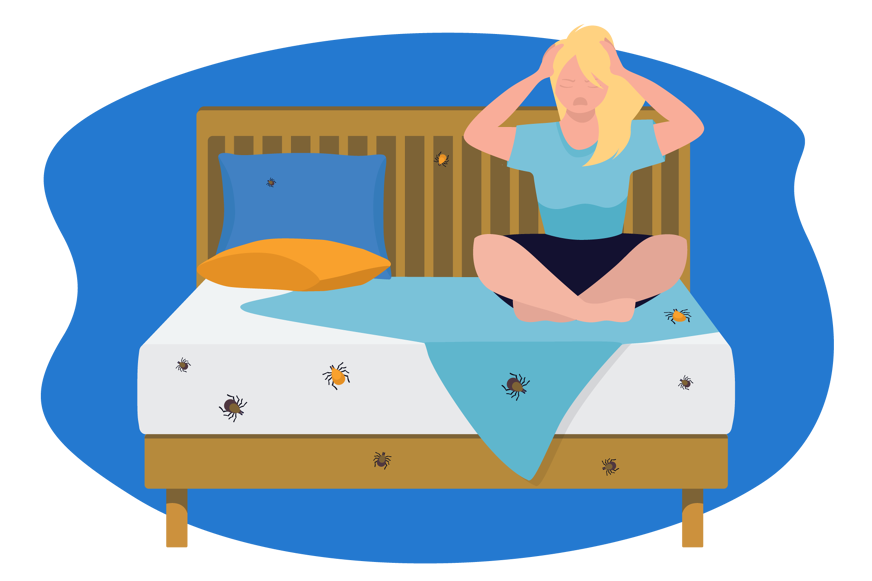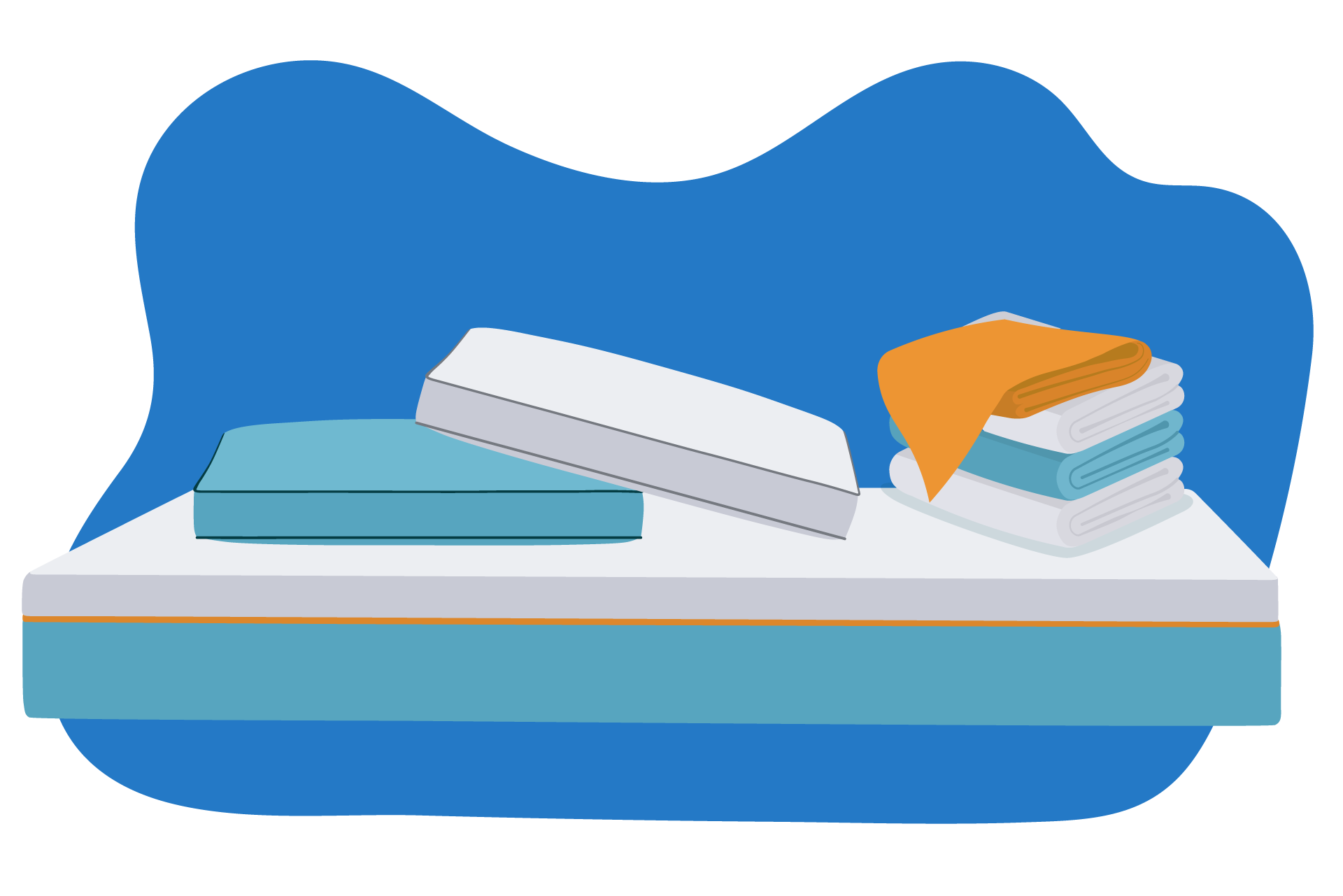How long can lice live on bedding without a host?
Lice have a limited survival rate without their primary food source: blood.
They can't live on your bedding for more than two to four days [1].
Still, if you suspect a lice invasion, washing sheets and pillowcases at a scorching 54.4°C (130°F) [2] is wise. 🔥
How long do lice eggs live on bedding?
Lice have the potential to find their way onto your bedding, pillows, and mattresses and lay eggs.

However, they can't thrive and hatch in such environments.
This is because they depend heavily on body heat and blood for survival.
Nymphs (baby lice) have a limited life span without food and will die within a week.
Unlike fleas and bed bugs, lice don't have the tendency to venture far from their human host.
Instead, they remain close rather than returning sporadically to feed.
What types of lice can be found in bedding?
There are 3 types of lice that can live on humans and may spread through your bedding:
- Head lice - Lives on the person’s head and cause itchiness. They spread through hair-to-hair contact. Very common in school-aged children.
- Body lice - A sesame-sized insect that lives on the body. The infected person may be living in crowded or unhygienic conditions. Severe symptoms include sores and infections.
- Pubic lice - Usually found in pubic hair around the groin, but can also be found on the chest, armpit, face, or even eyelashes. Pubic lice [3] is typically spread through sexual contact and may need to be treated with medicated creams or shampoos.
Lice need to feed on blood to survive and cannot survive on bedding for more than a few days. 💀
Washing bedding at a high temperature is an effective way to kill all types of lice.
Below, we’ll dive into all you need to know about head lice infestations and how to get rid of them. 👇
What are head lice?
Head lice and nits are small insects that live on human hair and feed off blood from the scalp.
What do head lice look like?
Lice are typically two to four millimetres long, sporting a greyish hue that can turn reddish-black after feeding.

Equipped with a head, two antennae, and three pairs of legs ending in pincers, they're adept at clinging to hair.
What do lice eat?
Lice feed solely on blood, using a unique biting and sucking mechanism. 🩸
A single lice may bite up to 4 times a day, which can cause the host immense itching.
How do head lice spread?
Lice and their eggs (known as nits) are primarily spread through close contact. 👫

Just one child with lice can sometimes be the catalyst for an entire group getting infested through head-to-head contact.
Kids with long hair are especially vulnerable, as lice can easily latch onto their hair using their specialised pincers. 🦟
Also, sharing items like headphones, hairbrushes, hats, or hair ties can lead to transmission.
Signs of head lice
Lice infestations, or pediculosis [4], typically result in an itchy scalp.

Frequent head-scratching is one of the most noticeable physical symptoms of head lice.
With increased lice reports from schools, it's vital to check the scalp on a regular basis. 🔎

We recommend checking for lice with a comb in natural daylight, as adult lice despise light and are easier to spot. 💡
Scalp pediculosis
Scalp pediculosis is the most widespread parasitic disease in the world.
This condition arises from a severe lice infestation.
However, anyone can fall victim to scalp pediculosis. 😣
Over-itching can lead to skin lesions, especially behind the ears and neck.

The World Health Organisation [5] revealed that pediculosis impacts several billion people around the world and is often predominant in schoolgoers. 🌍
It’s key to be vigilant before the symptoms of lice become severe.
How to get rid of lice overnight
Lice in the household can be frustrating. 😠
To get rid of lice, you must understand their life cycle and ensure all lice and nits are completely removed from the home.
But the following tips can help you get rid of lice quickly:
- Don't share clothing items like hats or scrunchies
- Assign individual pillowcases to each family member
- Regularly check your child's hair, especially after school or camps
- Comb the hair with olive, lavender, or tea tree oil
We’ll go into more detail below. 👇
Avoid sharing products
You should ensure each family member uses their own towels, pillows, and bedding.
Do not share brushes, scarves or hats and ensure the child is not sharing these items at school, particularly when there is a lice infestation.
Use over-the-counter products
The best head lice treatment can be bought in the form of anti-lice shampoos containing permethrin [6] or dimethicone 4% lotion [7]. 💊

Often, these shampoos remove the lice but not the nits.
Running a comb through the hair after using anti-lice shampoo is an important additional step to kill lice and nits.
Repeat 7-10 days later to ensure complete eradication.
Wash bedding and accessories
After treatment, you should wash all bedding and hair accessories using hot water above 54.4°C (130°F). 🧼

Non-washable items should be sealed in a plastic bag for up to two weeks to ensure complete eradication.
Try natural remedies to prevent lice
Olive oil is one of the best natural remedies for head lice.
Combining olive oil with a mixture of lavender and tea tree oil can effectively eradicate lice.

In fact, studies [8] show a 100% mortality rate after 30 minutes of treating lice with tea tree oil.
You should mix 3 tablespoons of olive oil with 1 tablespoon of tea tree oil and comb through your hair.
Other natural remedies such as vinegar, baking soda and mayonnaise have not proved effective enough to remove lice.
To sum up...
Lice infestations, though common, can be a source of distress for both children and parents. 😓
Regularly checking hair, machine washing clothes and bedding at high temperatures, and using lice-deterring remedies are the keystones to keeping these pesky parasites at bay.
Remember, it's not just about treating lice but preventing their return. 🚫












Alternatively, message us directly via the Contact Us page.